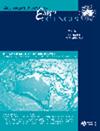Geodynamic evolution in the post-collisional stage of the East Kunlun Orogenic Belt: constraints from the Late Triassic intermediate–felsic igneous rocks
IF 0.9
4区 地球科学
Q3 GEOSCIENCES, MULTIDISCIPLINARY
引用次数: 0
Abstract
AbstractThe Late Triassic igneous rocks associated with post-collision are widely distributed in the East Kunlun Orogenic Belt (EKOB), but their specific dynamic mechanism and evolutional process are still controversial. To address these key issues, we investigated the geochronology and geochemistry of intermediate–felsic igneous rocks from the EKOB, including trachyandesite, rhyolite, porphyritic monzogranite, syenogranite, granite porphyry and crystalline tuff. Zircon U–Pb isotopes of these rocks indicate that they were formed between 231.1 and 215.8 Ma (i.e. Late Triassic). These igneous rocks have moderate to high SiO2 (60.29–79.56 wt%) and low mantle compatible element contents (e.g. Co: 0.37–12.62 ppm; Ni: 1.55–15.59 ppm), suggesting that continental crustal-derived material played an important role in their formation. Porphyritic monzogranite (231.1 Ma), syenogranite (228.1 Ma), trachyandesite (227.4 Ma) and rhyolite (215.8 Ma) have Nb/U (1.41–4.71) and Ce/Pb (1.48–6.19) ratios like that of the crust, with εHf(t) values (–1.31 to 2.26) and old two-stage model (TDM2) ages of 1340–1119 Ma, suggesting that they originated from the partial melting of a Mesoproterozoic crust with minor mantle material involved in their source. Crystalline tuff (224.6 Ma) and granite porphyry (222.3 Ma) have Nb/U (1.93–3.81) and Ce/Pb (0.30–3.18) ratios, negative εHf(t) values (–7.04 to −5.12) and old TDM2 ages (1703–1581 Ma) closer to those of crust, suggesting that they were derived from the partial melting of a Paleo–Mesoproterozoic continental crust without addition of mantle material. Based on our new data and published data, the Late Triassic igneous rocks from the EKOB can be divided into three stages, 236–227, 226–218 and 216–208 Ma, corresponding to slab break-off, lithospheric mantle delamination and thickened lower crust delamination, respectively.KEY POINTSThe intermediate–felsic igneous rocks from the East Kunlun Orogenic Belt are dated from 231.1 to 215.8 Ma (i.e. Late Triassic).These igneous rocks were derived from the partial melting of ancient continental crust.The Late Triassic igneous rocks from the East Kunlun Orogenic Belt can be divided into three stages, including slab break-off, lithospheric mantle delamination and thickened lower crust delamination.Keywords: East Kunlun Orogenic BeltLate Triassicpost-collisional magmatismgeodynamic evolutionintermediate–felsic igneous rocksslab break-offdelamination Data availability statementThe authors confirm that the data supporting the findings of this study are available within the article and the Supplemental data.Disclosure statementNo potential conflict of interest was reported by the author(s).Additional informationFundingThis research was funded by the Key Research Program of the National Natural Science Foundation of China (92062217), the Kunlun Talents High-end Innovative and Entrepreneurial Talents Project of Qinghai Province ([2022] No. 32), the Science and Technology Project of Qinghai Province (2019-ZJ-7009) and the Kunlun Talents High-end Innovative and Entrepreneurial Talents Project of Qinghai Province ([2021] No. 16).东昆仑造山带碰撞后的地球动力学演化:来自晚三叠世中英质火成岩的约束
摘要东昆仑造山带广泛分布有晚三叠世后碰撞伴生火成岩,但其具体的动力机制和演化过程仍存在争议。为了解决这些关键问题,我们研究了EKOB中长英质火成岩的年代学和地球化学,包括粗面山岩、流纹岩、斑状二长花岗岩、正长花岗岩、花岗斑岩和结晶凝灰岩。锆石U-Pb同位素表明,这些岩石形成于231.1 ~ 215.8 Ma(晚三叠世)之间。这些火成岩具有中高SiO2 (60.29-79.56 wt%)和低地幔相容元素含量(如Co: 0.37-12.62 ppm);Ni: 1.55 ~ 15.59 ppm),表明大陆地壳源物质在其形成过程中起了重要作用。斑岩型二长花岗岩(231.1 Ma)、正长花岗岩(228.1 Ma)、粗长山岩(227.4 Ma)和流纹岩(215.8 Ma)的Nb/U(1.41 ~ 4.71)和Ce/Pb(1.48 ~ 6.19)比值与地壳相似,εHf(t)值为-1.31 ~ 2.26,两阶段模式(TDM2)年龄为1340 ~ 1119 Ma,表明它们起源于中元古代地壳的部分熔融,来源中地幔物质较小。结晶凝灰岩(224.6 Ma)和花岗岩斑岩(222.3 Ma)的Nb/U(1.93 ~ 3.81)和Ce/Pb(0.30 ~ 3.18)比值,εHf(t)值为负(-7.04 ~ - 5.12),TDM2年龄(1703 ~ 1581 Ma)较接近地壳年龄,表明它们来源于古-中元古代大陆地壳的部分熔融,没有地幔物质的加入。根据新资料和已有资料,鄂西坳陷晚三叠世火成岩可划分为236 ~ 227 Ma、226 ~ 218 Ma和216 ~ 208 Ma三个阶段,分别对应于板块断裂、岩石圈地幔剥离和下地壳增厚剥离。东昆仑造山带的中长英质火成岩年龄为231.1 ~ 215.8 Ma(即晚三叠世)。这些火成岩是古代大陆地壳部分熔融形成的。东昆仑造山带晚三叠世火成岩可分为板块断裂、岩石圈地幔剥离和下地壳增厚剥离3个阶段。关键词:东昆仑造山带晚三叠世碰撞后岩浆地球动力学演化中英质火成岩岩裂脱层数据可用性声明作者在文章和补充资料中确认了支持本研究结果的数据。披露声明作者未报告潜在的利益冲突。本研究由国家自然科学基金重点研究项目(92062217)、青海省昆仑英才高端创新创业人才项目([2022]32号)、青海省科技计划项目(2019-ZJ-7009)、青海省昆仑英才高端创新创业人才项目([2021]16号)资助。
本文章由计算机程序翻译,如有差异,请以英文原文为准。
求助全文
约1分钟内获得全文
求助全文
来源期刊

Australian Journal of Earth Sciences
地学-地球科学综合
CiteScore
2.80
自引率
8.30%
发文量
45
审稿时长
6-12 weeks
期刊介绍:
Australian Journal of Earth Sciences publishes peer-reviewed research papers as well as significant review articles of general interest to geoscientists. The Journal covers the whole field of earth science including basin studies, regional geophysical studies and metallogeny. There is usually a thematic issue each year featuring a selection of papers on a particular area of earth science. Shorter papers are encouraged and are given priority in publication. Critical discussion of recently published papers is also encouraged.
 求助内容:
求助内容: 应助结果提醒方式:
应助结果提醒方式:


